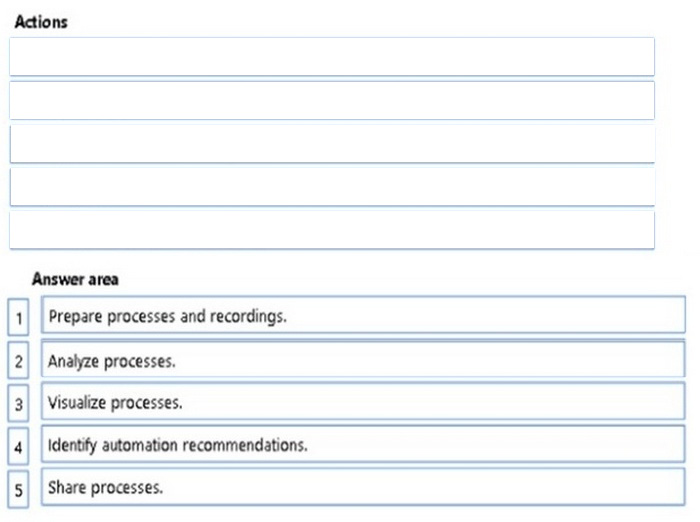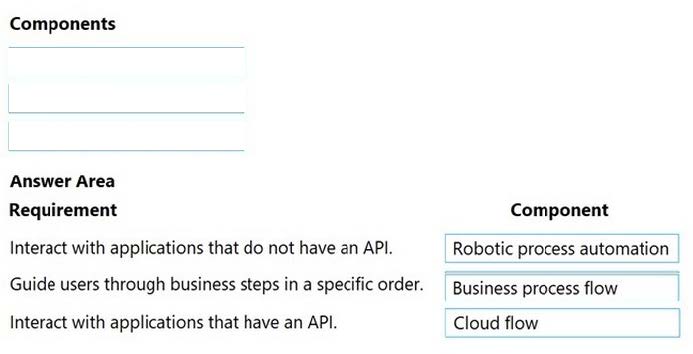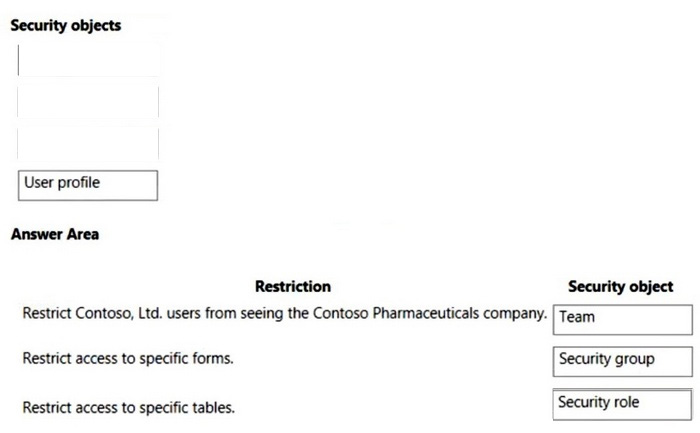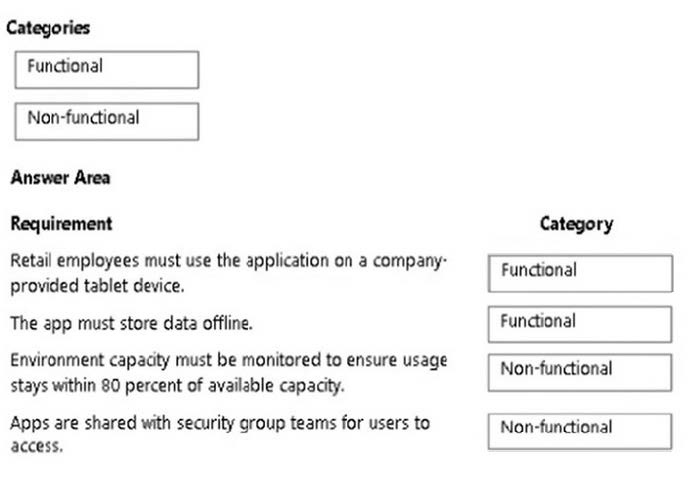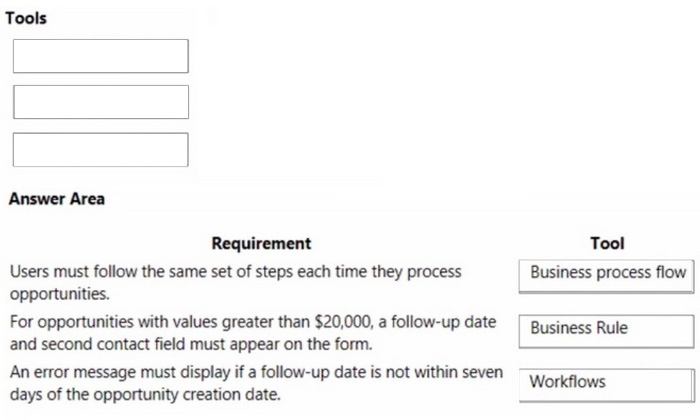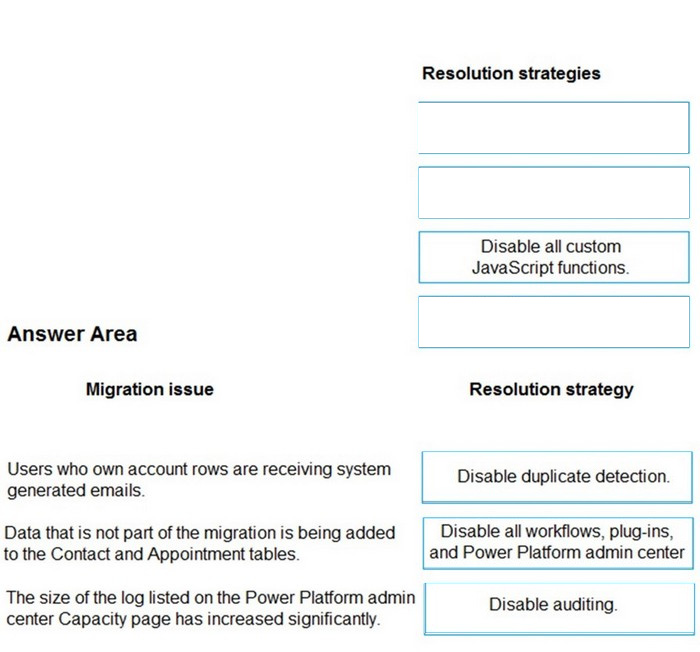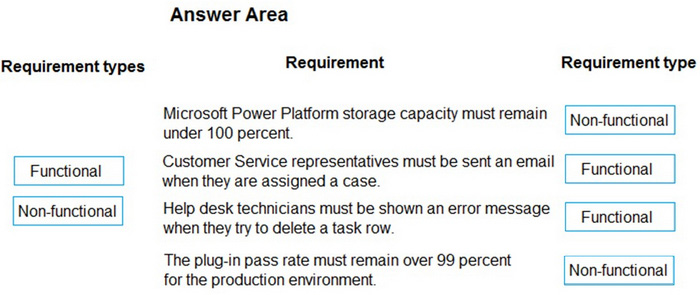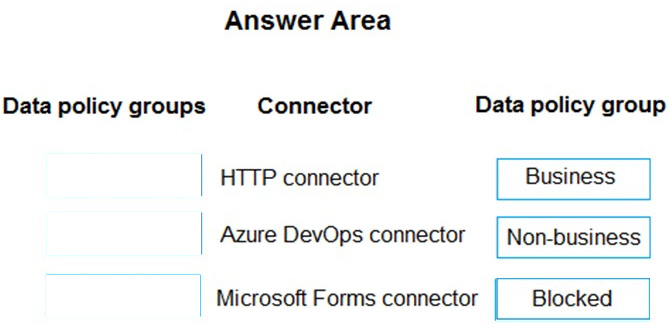Exam Details
Exam Code
:PL-600Exam Name
:Microsoft Power Platform Solution ArchitectCertification
:Microsoft CertificationsVendor
:MicrosoftTotal Questions
:238 Q&AsLast Updated
:Mar 23, 2025
Microsoft Microsoft Certifications PL-600 Questions & Answers
-
Question 131:
DRAG DROP
You are a Microsoft Power Platform architect.
You must identify and document your organization's business processes to identify opportunities for automation.
You need to run task mining in process advisor.
In which order should you perform the actions? To answer, move all actions from the list of actions to the answer area and arrange them in the correct order.
Select and Place:
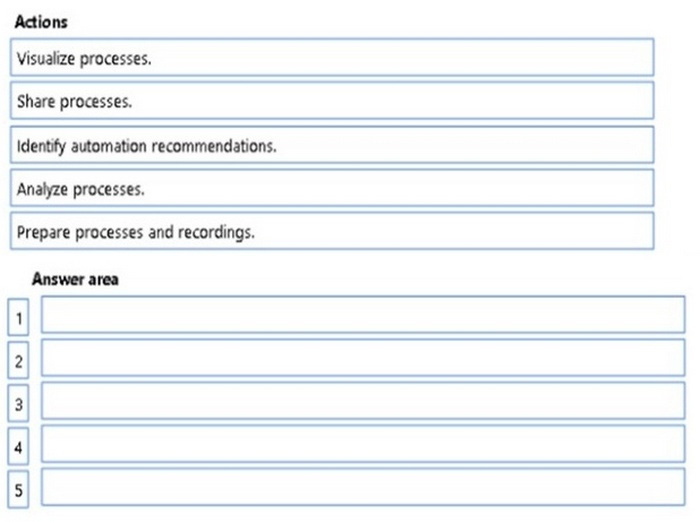
-
Question 132:
DRAG DROP
You are designing a solution to automate the following processes:
1.
Import data into Microsoft Dataverse from systems that have an API available.
2.
Import data into Microsoft Dataverse from systems that do not have an API available.
3.
Validate that users enter data into Microsoft Dataverse forms in a specified order.
You need to implement automation methods.
Which components should you use? To answer, drag the appropriate components to the correct requirements. Each component may be used once, more than once, or not at all. You may need to drag the split bar between panes or scroll to
view content.
NOTE: Each correct selection is worth one point.
Select and Place:
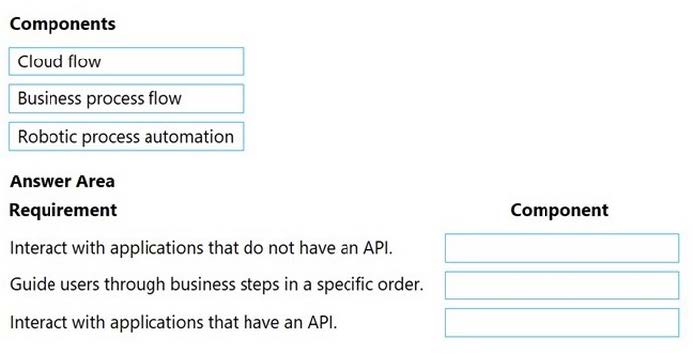
-
Question 133:
DRAG DROP
You are designing a Microsoft Power Platform solution that will be deployed to two separate companies in the same Microsoft Office 365 tenant: Contoso, Ltd. and Contoso Pharmaceuticals.
The solution must meet the following security requirements:
1.
Restrict Contoso, Ltd. users from seeing the Contoso Pharmaceuticals company.
2.
Restrict access to specific forms.
3.
Restrict access to specific tables.
What should you recommend? To answer, drag the appropriate security types to the correct restrictions. Each security type may be used once, more than once, or not at all. You may need to drag the split bar between panes or scroll to view
content.
NOTE: Each correct selection is worth one point.
Select and Place:
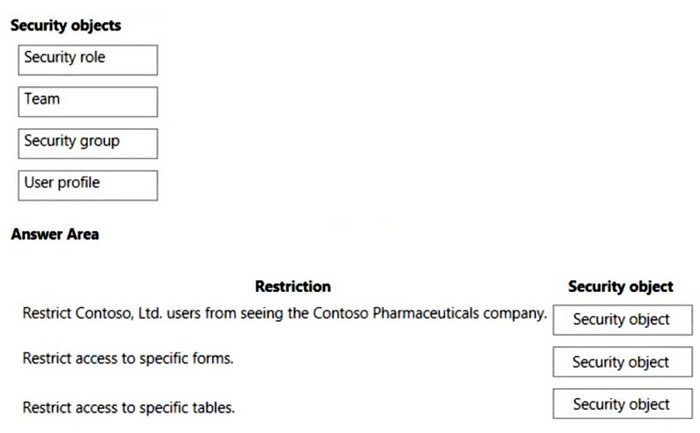
-
Question 134:
DRAG DROP
You are a Microsoft Power Platform solution architect capturing requirements for a national retail chain project.
The project has the following requirements:
1.
Retail employees must use the application on a company-provided tablet device.
2.
The app must store data offline.
3.
Environment capacity must be monitored to ensure usage stays within 80 percent of available capacity.
4.
Apps are shared with security group teams for users to access.
You need to identify the project's functional and non-functional requirements.
How should you categorize the requirements? To answer, drag the appropriate categories to the correct requirements. Each category may be used once, more than once, or not at all. You may need to drag the split bar between panes or
scroll to view content.
NOTE: Each correct selection is worth one point.
Select and Place:
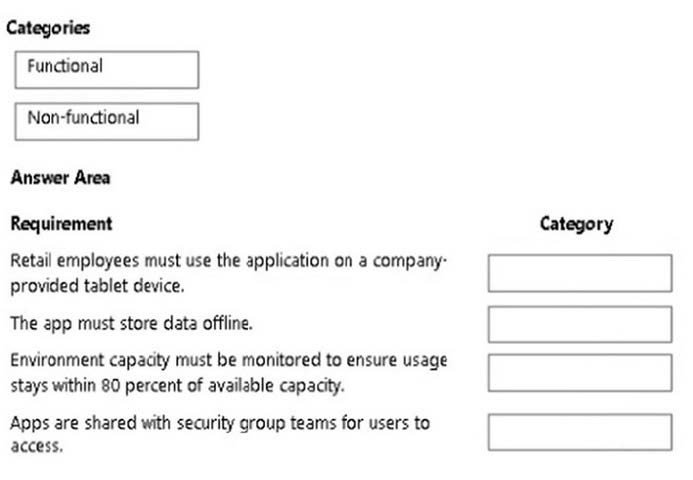
-
Question 135:
DRAG DROP
A client plans to implement Microsoft Power Platform solutions.
The client identifies the following requirements for handling opportunities:
1.
Users must follow the same set of steps each time they process opportunities.
2.
For opportunities with values greater than $20,000, a follow-up date and second contact field must appear on the form.
3.
An error message must display if a follow-up date is not within seven days of the opportunity creation date.
You need to recommend tools to meet the client requirements.
What should you recommend? To answer, drag the appropriate tools to the correct requirement. Each tool may be used once, more than once, or not at all. You may need to drag the split bar between panes or scroll to view content.
NOTE: Each correct selection is worth one point.
Select and Place:
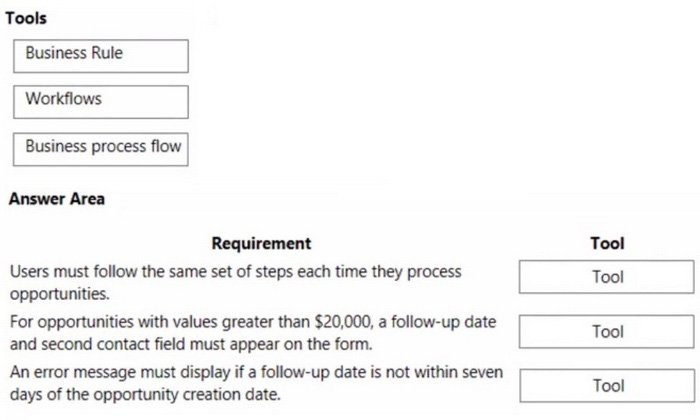
-
Question 136:
DRAG DROP
You are a Microsoft Power Platform architect reviewing requirements for an offline shopping app.
You need to identify requirement types for the app.
How should you categorize the requirements? To answer, drag the appropriate types to the correct requirements. Each type may be used once, more than once, or not at all. You may need to drag the split bar between panes or scroll to view
content.
NOTE: Each correct selection is worth one point.
Select and Place:
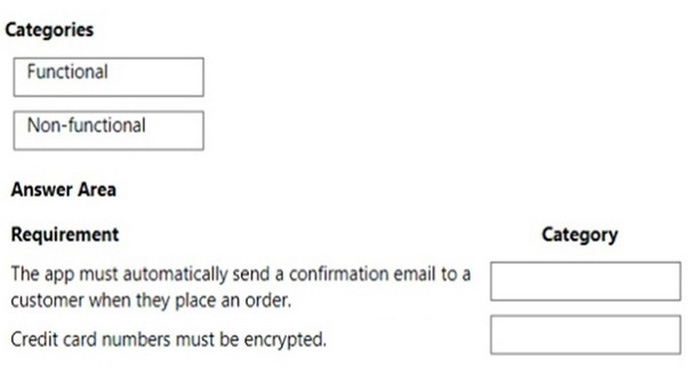
-
Question 137:
DRAG DROP
You are overseeing the data migration for a Microsoft Power Platform solution.
The migration team is performing a test migration with a subset of data. The migration team reports the following findings:
1.
Users who own account rows are receiving system generated emails.
2.
Data that is not part of the migration is being added to the Contact and Appointment tables.
3.
The size of the log listed on the Power Platform admin center Capacity page has increased significantly.
You need to recommend strategies to resolve the reported issues.
What should you recommend? To answer, drag the appropriate resolution to the correct migration problem. Each resolution may be used once, more than once, or not at all. You may need to drag the split bar between panes or scroll to view
content.
NOTE: Each correct selection is worth one point.
Select and Place:
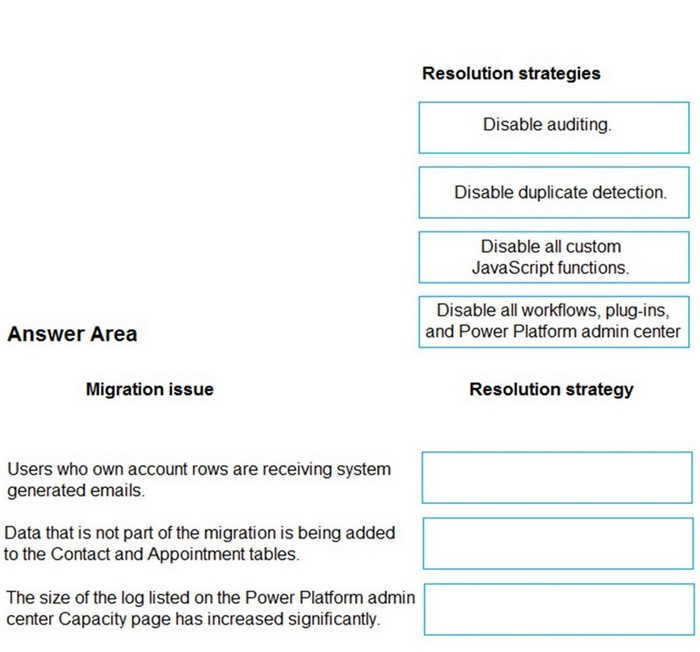
-
Question 138:
DRAG DROP
You are performing a requirements analysis for a customer.
The customer provides the following requirements:
1.
Power Platform storage capacity must remain under 100 percent.
2.
Customer service representatives must be sent an email when they are assigned a case.
3.
Help desk technicians must be shown an error message when they try to delete a task row.
4.
The plug-in pass rate must remain over 99 percent for the production environment.
You need determine if the requirements are functional or non-functional.
Which requirement type should you use? To answer, drag the appropriate requirement types to the correct requirements. Each requirement type may be used once, more than once, or not at all. You may need to drag the split bar between
panes or scroll to view content.
NOTE: Each correct selection is worth one point.
Select and Place:
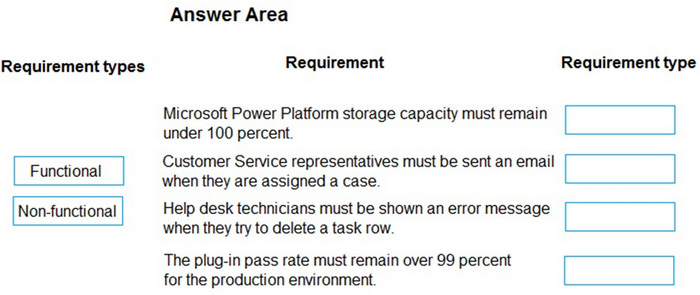
-
Question 139:
DRAG DROP
You are designing data loss policies for a Microsoft Power Platform implementation.
You have the following requirements:
1.
Solutions that use the HTTP connector must not include any other connectors.
2.
Prevent the use of the Microsoft Forms connector.
3.
Allow the use of the Azure DevOps connector.
You need to determine in which data policy group to add each connector.
To which data policy group should you assign the connector? To answer, drag the appropriate setting to the correct drop targets. Each source may be used once, more than once, or not at all. You may need to drag the split bar between
panes or scroll to view content.
NOTE: Each correct selection is worth one point.
Select and Place:
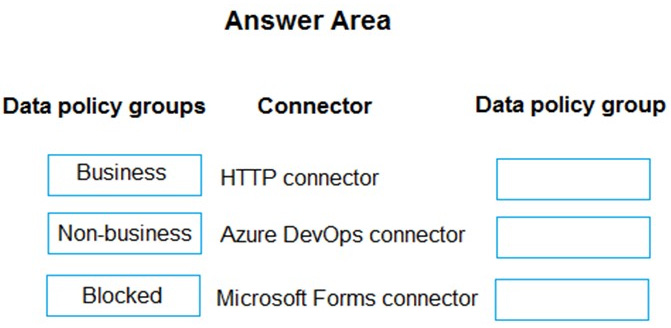
-
Question 140:
DRAG DROP
You need to recommend methods for assigning security to each group of users.
What should you recommend? To answer, drag the appropriate methods to the correct groups of users. Each method may be used once, more than once, or not at all. You may need to drag the split bar between panes or scroll to view content.
NOTE: Each correct selection is worth one point.
Select and Place:

Related Exams:
62-193
Technology Literacy for Educators70-243
Administering and Deploying System Center 2012 Configuration Manager70-355
Universal Windows Platform – App Data, Services, and Coding Patterns77-420
Excel 201377-427
Excel 2013 Expert Part One77-725
Word 2016 Core Document Creation, Collaboration and Communication77-726
Word 2016 Expert Creating Documents for Effective Communication77-727
Excel 2016 Core Data Analysis, Manipulation, and Presentation77-728
Excel 2016 Expert: Interpreting Data for Insights77-731
Outlook 2016 Core Communication, Collaboration and Email Skills
Tips on How to Prepare for the Exams
Nowadays, the certification exams become more and more important and required by more and more enterprises when applying for a job. But how to prepare for the exam effectively? How to prepare for the exam in a short time with less efforts? How to get a ideal result and how to find the most reliable resources? Here on Vcedump.com, you will find all the answers. Vcedump.com provide not only Microsoft exam questions, answers and explanations but also complete assistance on your exam preparation and certification application. If you are confused on your PL-600 exam preparations and Microsoft certification application, do not hesitate to visit our Vcedump.com to find your solutions here.
